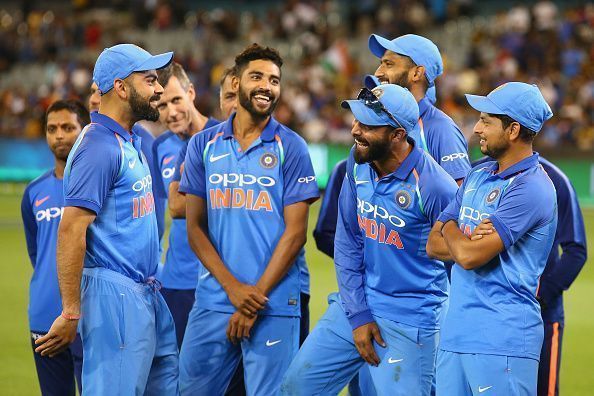
In the high-stakes arena of international cricket, where every performance is dissected and every decision scrutinised, the conversation around veteran players often walks a tightrope between admiration for past glories and speculation about future roles. For Indian cricket, two names have dominated this narrative for well over a decade: Rohit Sharma and Virat Kohli. As India gears up for a crucial three-match One Day International (ODI) series against Australia, commencing in Perth, the Chief Selector, Ajit Agarkar, has stepped forward to clarify their status, emphatically stating that these stalwarts are not `on trial`.
The Unquestionable Pedigree: Rohit and Kohli Beyond Scrutiny
The notion of putting players with averages well above (or close to) 50 on `trial` might indeed strike one as peculiar. Agarkar, in a recent address at the NDTV World Summit 2025, underscored this sentiment. “They are not on trial,” he stated, acknowledging their immense contributions and achievements, not just in terms of trophies but individual milestones. This isn`t just a vote of confidence; it`s a recognition of a legacy that transcends immediate results.
Both Rohit and Kohli have, in recent times, made significant career adjustments. Following their pivotal roles in India`s T20 World Cup triumph in 2024, they retired from the shortest format. This was followed by their retirement from Test cricket after the 2024-25 Australia tour, a decision aimed at making way for a younger generation as a new World Test Championship (WTC) cycle dawned. This strategic pruning of their playing commitments effectively casts them as ODI specialists, a curious evolution for players who once conquered all formats with unwavering consistency.
The 2027 World Cup Conundrum: A Glimpse into the Future?
With their focus now narrowed to the 50-over format, the natural question arises: what about the 2027 World Cup? Agarkar, ever the pragmatist, offered a dose of reality. “In two years` time, we don`t know what the situation is going to be.” This isn`t a veiled threat or an ominous forecast; it`s a simple acknowledgement of professional sport`s relentless march. While their current form and class are undeniable, the passage of time affects every athlete. The selectors, it seems, prefer to assess as they go, rather than making definitive pronouncements years in advance. The Indian cricketing establishment is looking for continuity, not a cliff-edge drop-off.
It’s a delicate dance: respecting the past while meticulously planning for the future. Rohit, notably, has also handed over the ODI captaincy to Shubman Gill, a clear sign of the ongoing leadership transition. This allows the senior batsmen to potentially focus solely on their primary craft, though the burden of expectation on their performance remains, if only for the sheer weight of their names.
Mohammed Shami`s Fitness Conundrum: A Pacer`s Plea and Selector`s Prudence
Beyond the illustrious batting duo, another veteran`s situation has stirred conversations: that of fast bowler Mohammed Shami. Shami, who hasn`t donned the Indian colours since the Champions Trophy in March, was conspicuously absent from the squad for the Australia tour, reportedly on fitness grounds. This decision, however, was met with a degree of public disagreement from the player himself.
“If I can play four-dayers [Ranji Trophy], I can also play 50-overs cricket,” Shami was quoted as saying, a sentiment that resonates with any athlete feeling sidelined despite believing in their own readiness.
Agarkar, addressing this directly, reiterated the selectors` stance while also emphasising an open channel of communication. “My phone is always on for most players, and I`ve had multiple chats with him over the last few months.” This suggests a continuous dialogue behind the scenes, attempting to bridge the gap between the player`s self-assessment and the board`s fitness benchmarks.
The selectors` primary concern, it appears, isn`t Shami`s undeniable quality – “with his quality, if he`s bowling well, why would you not want to have someone like a Shami?” Agarkar posed rhetorically – but rather his consistent physical readiness. Past incidents, including his absence from the crucial England tour due to fitness issues, clearly inform the current cautious approach. The ongoing Ranji Trophy season will serve as a crucial proving ground for Shami. His performances and, more importantly, his sustained fitness over a series of demanding matches, will be closely monitored.
The Evolving Landscape of Indian Cricket
The discussions surrounding Rohit, Kohli, and Shami highlight the dynamic and often challenging task of managing a top-tier international cricket team. It`s a tightrope walk between honouring legendary careers, fostering new talent, and ensuring peak physical condition for the rigours of modern cricket. Agarkar`s statements paint a picture of a selection committee striving for a pragmatic transition, one that respects the past while strategically building for the future.
For fans, the narrative is equally compelling. It’s a period where every series holds a double significance: the immediate quest for victory and the subtle shifts that shape the team’s long-term trajectory. As the Australian ODI series commences, it will not only be about runs and wickets but also about observing how these veteran players integrate into an evolving squad, proving not just their prowess, but their continued relevance in India`s ambitious cricketing journey. The trial, it seems, is less about individual performance and more about the collective evolution of a cricketing powerhouse.









